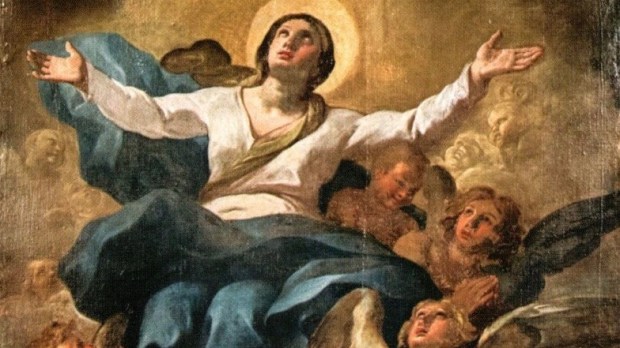Santa Marija (Our Lady of the Assumption) is the patroness of the people of the Maltese Islands, and reigns in their hearts. Indeed, the main feast of nine parishes is Santa Marija Assunta – on August 15, or a close date. Devotional life in Malta has always given special prominence to the Assumption and Santa Marija has always been the most popular feast and fount of widespread devotion. Its early origins, however, are difficult to trace.
Apocyphal accounts of Mary’s Assumption
Several early apocryphal sources, such as the Transitus Mariae (the Passing of Mary)— the earliest extant historical writings on the Assumption—describe Mary’s end on earth in Jerusalem. Scholars believe that the oldest of these (a work dating to the second century, is attributed to Leucius Karinus, a disciple of John) is based on an original document from the apostolic era by the evangelist himself.
These works are not accepted as part of the Christian canon of Scripture, but, according to the biblical scholar Lino Cignelli, “All of them are traceable back to a single primitive document, a Judaeo-Christian prototype, clearly written within the Mother Church of Jerusalem some time during the second century, and, in all probability, composed for liturgical use right at the Tomb of Our Lady.”
Given the 2000 years of Christian faith, and the deep Marian roots of the Maltese Islands (possibly originating from Saint Luke, during his stay with Saint Paul), it would not be surprising at all if devotion to the Assumption in Malta dates to the first centuries of Christianity.
A brief survey of the topographical distribution of churches dedication to the Assumption demonstrates the deep penetration of this Marian devotion in Maltese religious tradition.

Chronology and distribution of churches
All existing parishes (until the beginning of the 17th century, as well as the more important inhabited parts of the island) had at least one Assumption church, or an altar dedicated to her. In fact, three of the oldest parishes of the Maltese Islands are dedicated to the Assumption of the Blessed Virgin: Birkirkara which dates at least to 1402 (today St. Helen’s Basilica); the Matrix church within the Gozo’s Citadel, mentioned in 1435; and the parish of Bir Miftuħ, today Gudja, which is mentioned in the Rollo de Mello of 1436.
By 1800, Malta had 92 churches and 22 altars dedicated to the Assumption. Some were already very old, when Mgr. Pietro Dusina carried out his Apostolic visit in 1575! But, how many of these numerous medieval churches and chapels have survived?
Sadly, not many, since most were neglected and were very likely profaned canonically. A few of the survivors had their titles changed. Some 50 of these churches vanished; victims of time, abandonment, and the physical elements.
Churches of the Assumption and the test of time
Among the lost chapels is the that of Santa Marija Assunta on Filfla (Filfla is a minuscule islet, with an area of just 0.023sq mi, standing some 4.5 kilometres south of Malta); while among the survivors, there is the Santa Marija Chapel at Comino (Kemmuna), which is already mentioned in the 1274 documents. So, for centuries, the Assumption was literally in every corner of the Maltese archipelago!
In the past, at Qormi there were ten chapels dedicated to the Assumption, but today we find only five. Undoubtedly, the small church of Santa MarijaTal-Ħlas (the Assumption of Childbirth and Liberation)—on its own in a quiet area and the solitude of the Qormi countryside between Qormi and Żebbuġ on the outskirts of Wied is-Sewda—is the best-known of all the chapels of Qormi. The area is also known as Tal- Ħlas, proving the ancient connection with the Madonna tal-Ħlas.
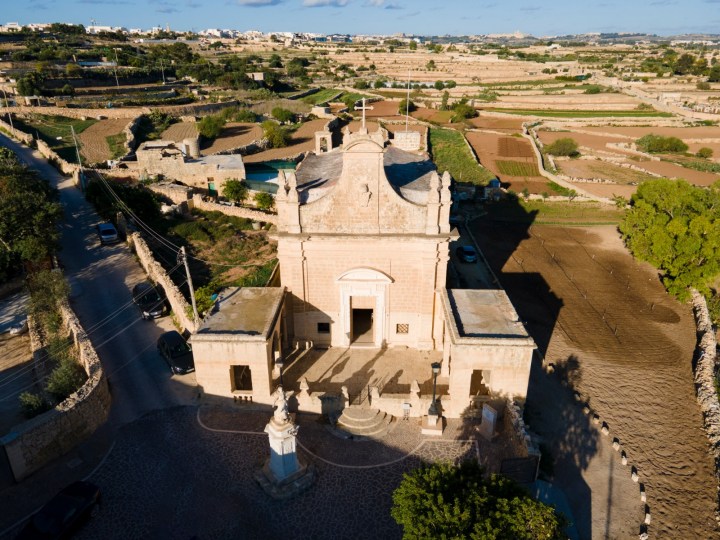
Our Lady of Liberation
The word ‘ħlas’ in Maltese can have several meanings: the most common being ‘childbirth’, but it can also mean liberation from slavery. Here, tradition steps in, saying that the name originates from the sound beating that the Aragonese gave the Saracen pirates which liberated our Islands from their frequent predatory raids.
We must remember that many Maltese were abducted by Muslim raiders to be sold in the slave markets of Tunis and Algiers. Relatives of the victims made every sacrifice to locate their loved ones to ransom them.
As the Maltese always turn to their Heavenly Mother for help, even in these sorts of calamities, they prayed to Mary to assist them in raising the ransom money, hence the words ‘ħlas’ (in this case it would also mean payment) and ‘liberation.’
Our Lady of Childbirth
The proper and official dedication of this chapel is to theAssumption of Our Lady. No one has—as yet—established what connection, if any, existed between childbirth and this particular devotion to Our Lady. However, we are on sure ground when we say that for the past several centuries, the popular devotion of the chapel is that of ‘Our Lady of Childbirth.’
And that is why so many parents visit the church to present their newly-born child to Our Lady. Indeed, pregnant women have invoked help and assistance from Mary, Mother of God and of all humankind. New mothers bring their babies to the shrine to present them to the Blessed Virgin, a truly special devotion to the Virgin’s Divine Maternity.
Ever since its construction, the chapel was the devotional centre of the country people of the entire area; and its geographical position—halfway in the route from Vittoriosa to Mdina—made it a resting place for both the people living in the harbor area and for those residing in the ancient capital and Rabat.
Adjacent to the church there was a small cemetery which people from all over the islands used to visit. Legend has it that a holy hermit who lived in the vicinity of this cemetery had spent his entire life praying for the repose of the dead.
It is traditionally held that the first Church dedicated to Santa Marija tal-Ħlas was built around the end of the fifteenth century. At the time the Maltese Islands formed part of the King’s royal demesne.
The Church of Our Lady of the Assumption of Childbirth and Liberation restored
It seems that in the mid-sixteenth century, the church was in a very bad state and, in 1560, the Knight of Saint John and Treasurer of the Order, Fra Christopher Le Boulleur de Montgauldri, decided to rebuild the church. Montgauldri was known to be very devoted to the Blessed Virgin. He also paid for the old titular painting: a depiction of the Madonna on clouds with Saint Paul and Saint John the Baptist (Patron of the Order) standing and looking upwards on either side. The painting also shows his coat-of-arms, and the year when it was executed (1573).
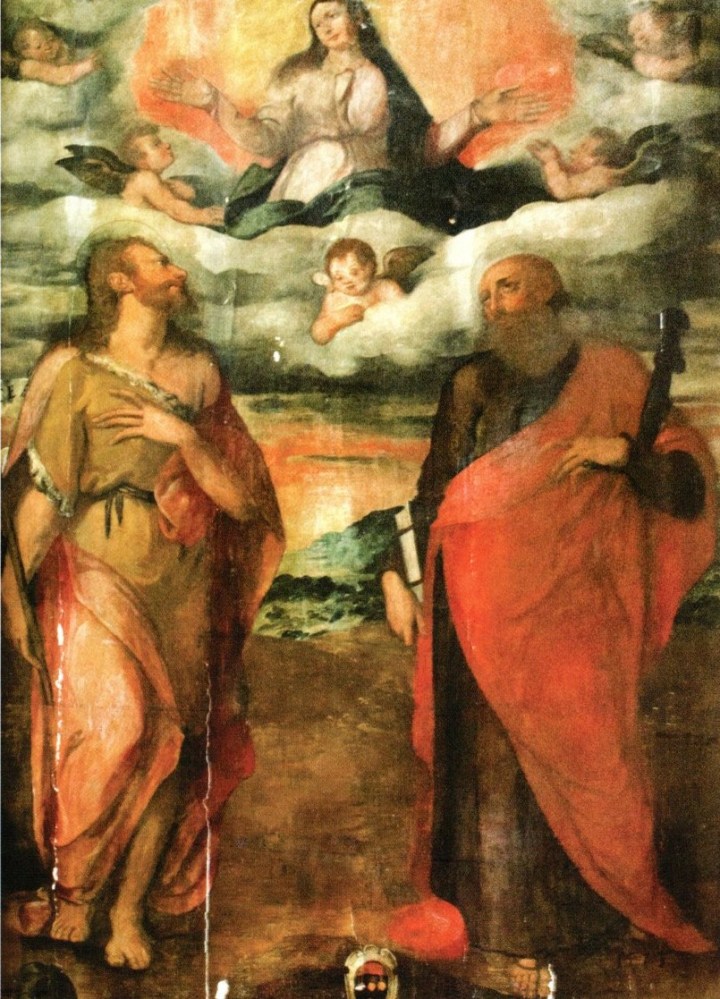
This painting is of great artistic value but, nowadays, it is kept in the Collegiate Parish Church of St. George the Martyr of Qormi. Before going at sea on the vessels of the Order, Montgauldri used to visit Tal-Ħlas and pray to the Madonna for protection. And, on his return, off he went again to thank Her for bringing him back safe and sound. All Apostolic delegates visiting this church throughout the centuries remarked that Tal-Ħlas enjoyed a widespread devotion.
Offerings and the devotion of the Maltese people
Votive offerings show the deep trust the Maltese have in the Blessed Virgin, especially in times of crisis and national calamities. They are immortal reminders to Marian devotion in the Maltese Islands throughout the centuries.
The sacristy of the Santa Marija Tal-Ħlas Church is full of such offerings, both ancient and recent. These witness extraordinary graces granted by the Blessed Virgin, related to healing from illness, being saved from accidents at sea, and safe childbirth.
We even find baby clothes sent from Canada as part of a pledge. This shows that the church is still very popular among women expecting a child. Some votive paintings have the signature of great painters, indeed, at Tal-Ħlas one of the paintings is by Anton Inglott.
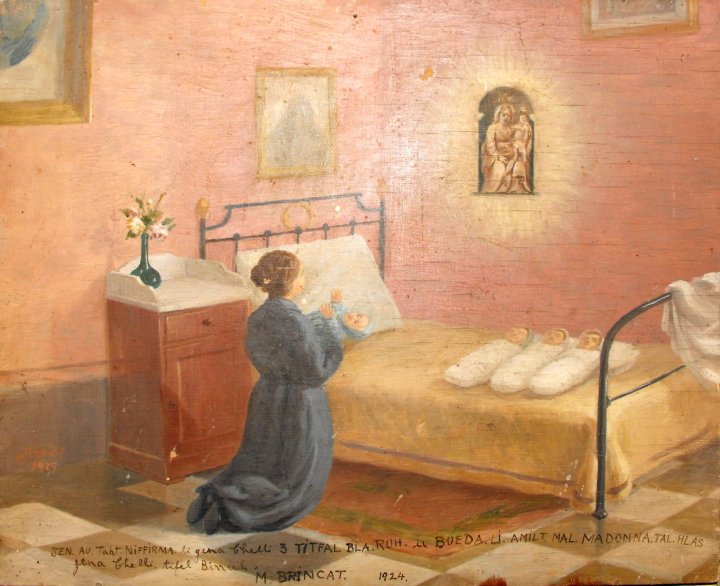
These paintings also prove the interventions of Our Lady to help women facing difficulties during pregnancy. For instance, the adjoining votive painting was offered by a certain M. Brincat, in 1924, for having saved her fourth new-born, after losing three others.
The sanctuary’s paintings
The Madonna tal-Ħlas church houses many paintings, some of which are of great artistic value. Apart from the old titular painting, paid for by Montgauldri, now housed in the Collegiate Parish Church of Saint George the Martyr of Qormi, we also find the new titular painting dedicated to the Assumption. Once erroneously attributed to Francesco Zahra (1710-1773), research has shown this attribution to be incorrect. The authorship of the painting is unknown although it has now been ascertained that it was imported from Rome in c.1729, the date inscribed at the bottom of the titular painting where there is also an undecipherable name, very probably belonging to the artist.
The walls of Tal-Ħlas are also covered with several historical graffiti. In front of the parvis one finds a beautiful stone statue of the Assumption of Our Lady. It was sculpted by Vincenzo Decandia in 1867 and has an inscription affixed to its high but finely constructed plinth which records that on the 8th January 1868 Bishop Gaetano Pace Forno granted a 40 days’ indulgence to whomever recites an Ave Maria in front of the statue.
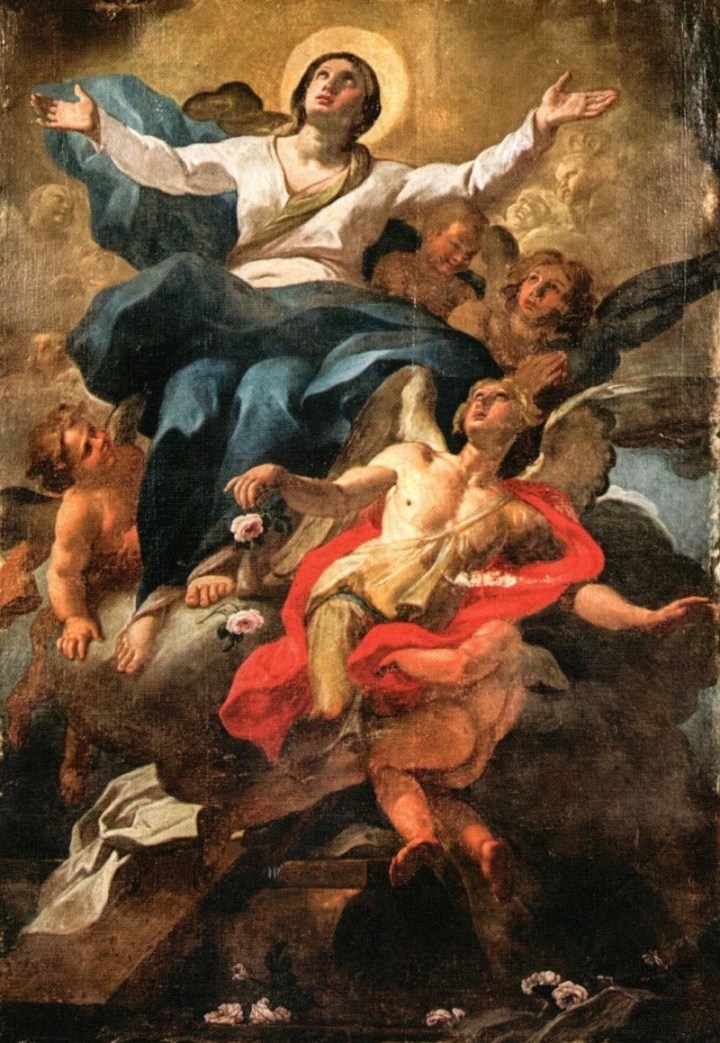
Celebration of the feast
At Tal-Ħlas, the feast of Marija Assunta used to be celebrated on the 15th of August, but was later moved to the following Sunday; however, the pomp and splendour of the feast flourished even more than before. The church is also opened on every third Sunday of the month, to celebrate a special Holy Mass for the presentation of newly-born children to Our Lady of Tal-Ħlas.
The feast of the Assumption is still celebrated nowadays, with Holy Mass in the morning and a fair in the evening. During this Mass newly-born babes are presented to the Madonna, and all those who had presented their babies during that year are invited to this celebration.
Special thanks to Dr. Joseph Grima, historian and expert in Marian devotion in the town of Qormi, for contributions to this article.
